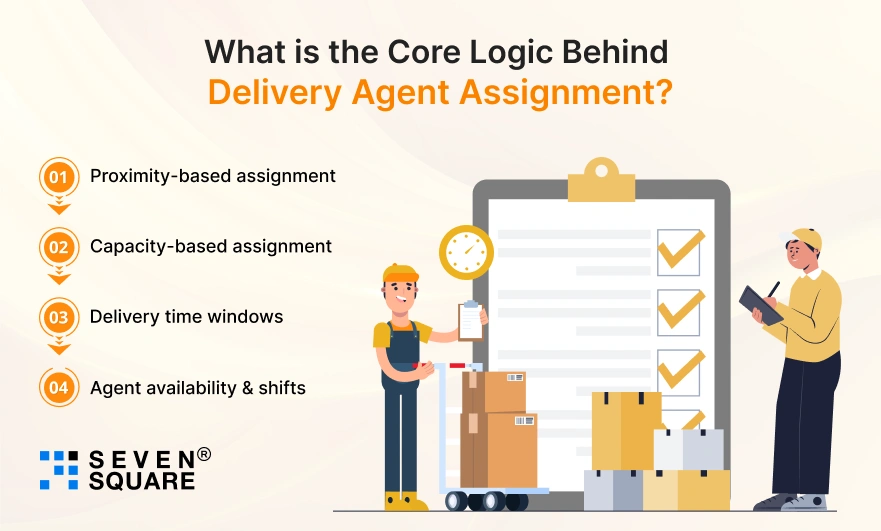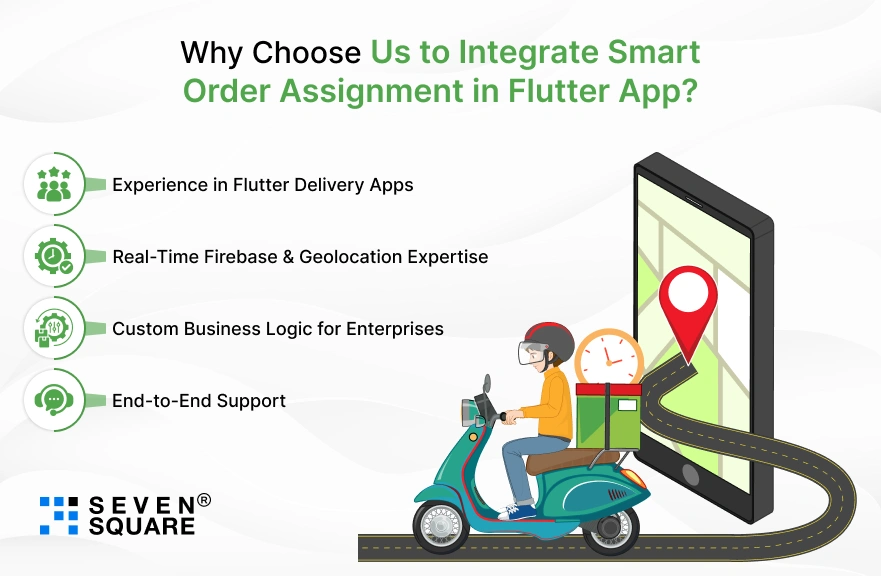Imagine your food arrives late just because the wrong driver was assigned.
The restaurant prepared your order on time, but the delivery agent was far away, stuck in traffic, and another closer driver was free.
This is where a last mile delivery algorithm and a dispatch algorithm come into play.
Nowadays, businesses can’t afford poor delivery experiences.
A Flutter delivery app without smart order assignment logic is like a car without navigation, inefficient and frustrating.
By implementing an intelligent system, we can assign orders to the right delivery agent at the right time.
In this blog, we’ll not only explain the logic and algorithms behind smart assignments but also build them practically.
You’ll get real Flutter code snippets and a GitHub repo you can clone to create your working system.
By the end, you’ll know how to build a smart order assignment system in Flutter that improves efficiency, reduces costs, and keeps customers happy.
Order Assignment vs Route Optimization: What’s the Difference?
Many people confuse order assignment logic with route optimization, but they’re not the same.
- Order assignment decides which driver gets which order.
- Route optimization decides what path the driver takes once assigned.
For example: In a food delivery app, the system must first assign the order to the nearest driver (assignment) and then calculate the best route with minimum traffic delays (optimization).
Here’s a simple comparison:
| Feature | Order Assignment Logic | Route Optimization |
|---|---|---|
| Definition | Decides which delivery agent takes the order. | Decides best path/route for delivery. |
| Example | Assigning Order #123 to Driver A. | Finding the shortest route for Driver A. |
| Core Goal | Fair, fast, and smart dispatching system. | Minimize travel time & distance. |
What is the Core Logic Behind Delivery Agent Assignment?

A smart delivery agent assignment system must balance multiple real-world factors. Let’s explore the core logic behind it:
- Proximity-based assignment: Assign orders to the agent closest to the pickup point using geolocation.
- Capacity-based assignment: Ensure drivers are not overloaded. Example: A rider carrying 3 orders cannot take a 4th.
- Delivery time windows (SLA): Some orders have time-window delivery scheduling, like groceries within 30 minutes.
- Agent availability & shifts: A driver off-shift or marked unavailable should not receive new tasks.
This is where dynamic order assignment becomes powerful.
Instead of manually dispatching, the system adapts in real time based on driver location, capacity, and customer needs.
Learn to Build a Food Delivery App.
What Are the Algorithms That Help in Smart Order Assignment?
Behind every dispatch algorithm, there is math and logic. Here are three common approaches:
1. Greedy Algorithm (Fast but Limited)
- Choose the nearest available driver immediately.
- Great for small fleets.
- Weakness: Doesn’t consider future orders or load balancing.
2. Hungarian Algorithm (Optimal for Small Scale)
- Finds the most cost-effective pairing of drivers and orders.
- Ensures fairness and balance.
- Works best for smaller businesses with limited drivers.
3. Heuristics / ALNS Metaheuristic (Best for Large Fleets)
- Advanced method for large-scale delivery platforms like food and grocery apps.
- Handles multiple constraints (distance, time windows, capacity).
- More complex but scales better.
Explore the Role of AI in Food Delivery Apps.
How to Set Up a Flutter Delivery App for Order Assignment?
Before building smart order assignment logic, let’s set up the basics of our Flutter delivery app.
Step 1: Create a new Flutter delivery app project
Run the following command:
flutter create delivery_assignment_app
cd delivery_assignment_app
This creates a starter project where we’ll add order assignment logic.
Step 2: Integrate Firebase Firestore for real-time orders & drivers
Firestore is ideal for real-time updates between customers, orders, and delivery agents.
Add dependencies in pubspec.yaml:
dependencies:
cloud_firestore: ^5.4.2
firebase_core: ^3.3.0
Initialize Firebase in main.dart:
import 'package:flutter/material.dart';
import 'package:firebase_core/firebase_core.dart';
void main() async {
WidgetsFlutterBinding.ensureInitialized();
await Firebase.initializeApp();
runApp(const MyApp());
}
class MyApp extends StatelessWidget {
const MyApp({super.key});
@override
Widget build(BuildContext context) {
return MaterialApp(
title: 'Delivery Assignment',
home: Scaffold(
appBar: AppBar(title: const Text('Smart Order Assignment')),
body: const Center(child: Text("Setup Done ✅")),
),
);
}
}
Step 3: Add Google Maps + Geolocation
We’ll use Google Maps for location tracking and the Haversine formula to calculate distances.
Add dependencies:
dependencies:
google_maps_flutter: ^2.6.0
geolocator: ^11.1.0
Implementing Smart Assignment Logic in Flutter (With Code + GitHub)
Now, let’s build the order assignment logic step by step.
Fetching available drivers from Firestore
import 'package:cloud_firestore/cloud_firestore.dart';
Future<List<Map<String, dynamic>>> fetchAvailableDrivers() async {
final driversSnapshot = await FirebaseFirestore.instance
.collection('drivers')
.where('isAvailable', isEqualTo: true)
.get();
return driversSnapshot.docs.map((doc) => doc.data()).toList();
}
This gets all active drivers ready to take new orders.
Calculating nearest driver with Haversine formula
import 'dart:math';
double haversineDistance(double lat1, double lon1, double lat2, double lon2) {
const R = 6371; // Earth radius in km
final dLat = (lat2 - lat1) * pi / 180.0;
final dLon = (lon2 - lon1) * pi / 180.0;
final a = pow(sin(dLat / 2), 2) +
cos(lat1 * pi / 180) *
cos(lat2 * pi / 180) *
pow(sin(dLon / 2), 2);
final c = 2 * atan2(sqrt(a), sqrt(1 - a));
return R * c; // distance in km
}
Assigning orders with fallback logic (manual dispatch panel)
Future<String?> assignOrderToNearestDriver(
double orderLat, double orderLon) async {
final drivers = await fetchAvailableDrivers();
if (drivers.isEmpty) {
// fallback → admin manual dispatch panel
return "No drivers available. Please use admin panel.";
}
drivers.sort((a, b) {
final distA = haversineDistance(orderLat, orderLon,
a['lat'] as double, a['lon'] as double);
final distB = haversineDistance(orderLat, orderLon,
b['lat'] as double, b['lon'] as double);
return distA.compareTo(distB);
});
final nearestDriver = drivers.first;
await FirebaseFirestore.instance
.collection('orders')
.doc('order123')
.update({'assignedTo': nearestDriver['id']});
return nearestDriver['id'];
}
This ensures nearest driver selection in Flutter while keeping a fallback manual dispatch panel.
Explore the Complete GitHub Code for Smart Order Assignment for Delivery Agents in Flutter.
Testing & Optimizing Your Order Assignment System
Once the system works, test for scale and reliability.
- Unit testing: Validate assignment logic with mock drivers.
- Load testing: Simulate thousands of orders in parallel.
- Optimistic updates & Firestore transactions: Prevent conflicts when two admins try to assign the same order.
Why Choose Us to Integrate Smart Order Assignment in Flutter App?

At Seven Square, we specialize in building high-performance Flutter delivery apps with intelligent order assignment logic.
Whether you’re a startup or an enterprise, we help you transform your last mile delivery operations into a scalable, customer-friendly system.
- Experience in Flutter Delivery Apps: We have built multiple apps with Google Maps Flutter delivery, real-time Firebase integration, & background location tracking.
- Real-Time Firebase & Geolocation Expertise: Our team ensures flutter firebase real-time location tracking & smooth updates for driver assignment logic.
- Custom Business Logic for Enterprises: We implement dynamic order assignment, capacity-based rules, time-window delivery scheduling, and fallback manual dispatch panels to match your exact workflows.
- End-to-End Support: From idea to deployment, we provide app, documentation, and ongoing support to help your business launch faster and deliver better.
Want a Custom Flutter App? Contact Us Today!
What Are the Advanced Improvements for Real-World Delivery Apps?
Real businesses need smarter assignment logic. Here’s how to scale:
1. Prioritize VIP/time-sensitive orders
- Add flags for priority orders and dispatch them first.
- Example: Grocery orders due in 15 mins get auto-priority.
2. Handling driver availability & shifts
- Add fields like isAvailable and shiftEndTime in Firestore.
- Prevent assigning orders to unavailable drivers.
3. Add capacity-based assignment
- Track how many orders a driver is carrying.
- Reject assignment if capacity limit reached.
4. Fallback to manual dispatch panel
- If no drivers are available, escalate to an admin panel.
FAQs
- You can use Flutter with Firebase and Google Maps APIs to fetch driver locations, calculate nearest driver, and update assignments in real time.
- Our GitHub repo shows this with working code.
- Order assignment decides which driver takes the order, while route optimization finds the fastest path for delivery.
- Both work together to improve last mile efficiency.
- For small fleets, the Greedy Algorithm or Hungarian Algorithm works well.
- For large businesses, heuristics or ALNS metaheuristics handle complex real-world constraints better.
- Firebase enables real-time tracking of drivers.
- When an order is placed, the system instantly finds the nearest available agent and updates the assignment dynamically.